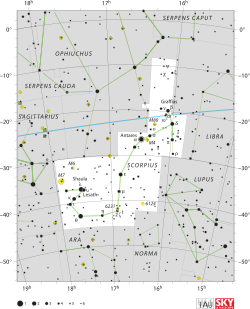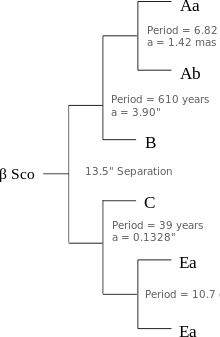Beta Scorpii

| |
| Observation data Epoch J2000.0 Equinox J2000.0 | |
|---|---|
| Constellation | Scorpius |
| HR 5984 | |
| Right ascension | 16h 05m 26.23198s[1] |
| Declination | –19° 48′ 19.6300″[1] |
| Apparent magnitude (V) | 2.63[2] |
| HR 5985 | |
| Right ascension | 16h 05m 26.57128s[1] |
| Declination | –19° 48′ 06.8556″[1] |
| Apparent magnitude (V) | 4.92[2] |
| Characteristics | |
| Spectral type | B1V + B2V |
| U−B color index | –0.08 / –0.70[2] |
| B−V color index | –0.08 / –0.02[2] |
| Astrometry | |
| HR 5984 | |
| Radial velocity (Rv) | –1.0[3] km/s |
| Proper motion (μ) | RA: –5.20[1] mas/yr Dec.: –24.04[1] mas/yr |
| Parallax (π) | 8.07 ± 0.78[1] mas |
| Distance | 400 ± 40 ly (120 ± 10 pc) |
| HR 5985 | |
| Radial velocity (Rv) | –3.6[3] km/s |
| Proper motion (μ) | RA: –5.07[1] mas/yr Dec.: –25.87[1] mas/yr |
| Parallax (π) | 8.19 ± 1.17[1] mas |
| Distance | 400 ± 40 ly (approx. 120 pc) |
| Details | |
| HR 5984 | |
| Mass | 10[4] M☉ |
| Radius | 19 R☉ |
| Luminosity | 20,000[4] L☉ |
| Temperature | 27,000[4] K |
| Rotational velocity (v sin i) | 100[5] km/s |
| HR 5985 | |
| Temperature | 22,000[4] K |
| Rotational velocity (v sin i) | 65[5] km/s |
| Other designations | |
| Database references | |
| SIMBAD | data |
Beta Scorpii (β Sco, β Scorpii) is a multiple star system in the southern zodiac constellation of Scorpius. It has the traditional names Acrab, Akrab or Elacrab, all come from (Arabic: العقرب) al-'Aqrab, the Scorpion, for the whole constellation, as well as Graffias,[6][7] a name it shares with Xi Scorpii. It was known as 房宿四 (the Fourth star of the Room) in Chinese.

Observed through a small telescope, Beta Scorpii appears as a binary star with a separation between the two components of 13.5 arcseconds. This pair, β1 and β2, form the top branches of the hierarchy of orbiting components in this system. β1 Scorpii, the brighter of the pair, consists of two sub-components, β Sco A and β Sco B, orbiting at an angular separation of 3.9 arcseconds with an orbital period of 610 years. β Sco A is itself a spectroscopic binary with the components β Sco Aa and β Sco Ab separated by 1.42 milliarcseconds and an orbital period of 6.82 days.[8]
The second visual component, β2 Scorpii, has two sub-components, β Sco C and β Sco E, orbiting at an angular separation of 0.1328 arcseconds with an orbital period of 39 years. β Sco E is a spectroscopic binary with the components β Sco Ea and β Sco Eb having an orbital period of 10.7 days. This brings the total number of stars in the system to six. There is no D component; this is now an artifact of earlier system models.[8]
The two most massive members of the system have the spectrum of B-type main sequence stars. Component C has a stellar classification of B2V.[8] They are both hot stars at least 10 times as massive as our own Sun, and will have short lives. Both are expected to end their stellar evolution with massive Type II supernova explosions.
The Beta Scorpii system is a kinematic member of the Upper Scorpius subgroup of the Scorpius-Centaurus Association, a group of thousands of young stars with mean age 11 million years at distance 470 light years (145 parsecs).[9] A recent analysis of the HR diagram position for the most massive star Beta-1 Scorpii A[9] estimates its effective temperature to be 26,240 Kelvin with a luminosity of 19,500 Suns, consistent with an isochronal age of 11 million years and an estimated mass of 12 solar masses.
Beta Scorpii is 1.01 degree from the ecliptic and can be occulted by the Moon and, very rarely, by planets. The last occultation by a planet took place on 13 May 1971, by Jupiter.
In culture
Beta Scorpii appears on the flag of Brazil, symbolising the state of Maranhão.[10] USS Graffias (AF-29) was once a United States navy ship named after the star.
References
- ↑ 1.0 1.1 1.2 1.3 1.4 1.5 1.6 1.7 1.8 1.9 van Leeuwen, F. (November 2007), "Validation of the new Hipparcos reduction", Astronomy and Astrophysics 474 (2): 653–664, arXiv:0708.1752, Bibcode:2007A&A...474..653V, doi:10.1051/0004-6361:20078357
- ↑ 2.0 2.1 2.2 2.3 Johnson, H. L. et al. (1966), "UBVRIJKL photometry of the bright stars", Communications of the Lunar and Planetary Laboratory 4 (99), Bibcode:1966CoLPL...4...99J
- ↑ 3.0 3.1 Evans, D. S. (June 20–24, 1966), Batten, Alan Henry; Heard, John Frederick, ed., The Revision of the General Catalogue of Radial Velocities, University of Toronto: International Astronomical Union, retrieved 2009-09-10
- ↑ 4.0 4.1 4.2 4.3 Kaler, James B. "GRAFFIAS (Beta Scorpii)". University of Illinois. Retrieved 2010-02-20.
- ↑ 5.0 5.1 Abt, Helmut A.; Levato, Hugo; Grosso, Monica (July 2002), "Rotational Velocities of B Stars", The Astrophysical Journal 573 (1): 359–365, Bibcode:2002ApJ...573..359A, doi:10.1086/340590
- ↑ http://www.jstor.org/stable/40692425 R. G. Aitken Publications of the Astronomical Society of the Pacific Vol. 36, No. 211 (June, 1924), pp. 124-130
- ↑ Allen, R. H., (1899) Star-names and Their Meanings, New York: G. E. Stechert, p. 367.
- ↑ 8.0 8.1 8.2 8.3 Mason, Brian D.; Hartkopf, William I.; Tokovinin, Andrei (September 2010), "Binary Star Orbits. IV. Orbits of 18 Southern Interferometric Pairs", The Astronomical Journal 140 (3): 735–743, Bibcode:2010AJ....140..735M, doi:10.1088/0004-6256/140/3/735
- ↑ 9.0 9.1 Mark J. Pecaut, Eric E. Mamajek, & Eric J. Bubar (February 2012). "A Revised Age for Upper Scorpius and the Star Formation History among the F-type Members of the Scorpius-Centaurus OB Association". Astrophysical Journal 746 (2): 154. arXiv:1112.1695. Bibcode:2012ApJ...746..154P. doi:10.1088/0004-637X/746/2/154.
- ↑ "Astronomy of the Brazilian Flag". FOTW Flags Of The World website.
External links
| ||||||||||||||||||||||||||||||||||